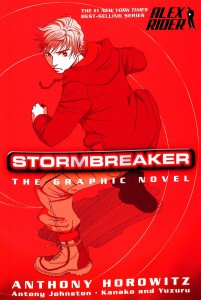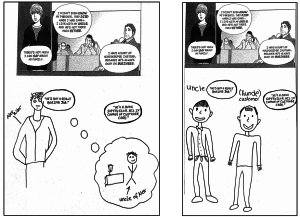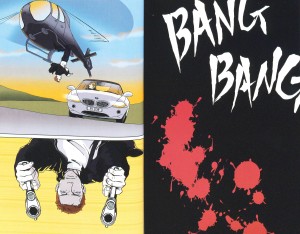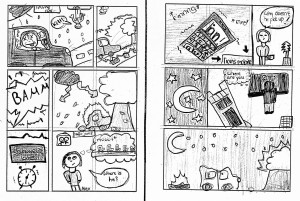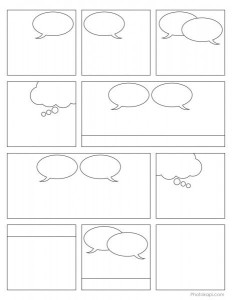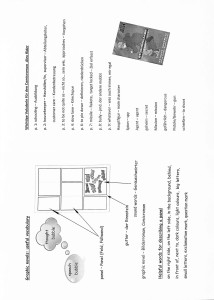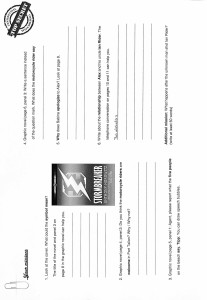| Alex Rider – Stormbreaker: A Graphic Novel Experience in a German EFL Classroom
Svenja Brinkmann |
Download PDF |
Abstract
This article gives an insight into the use of the graphic novel Alex Rider – Stormbreaker (Horwitz, 2006) in a German secondary school (Realschule). It begins with a short literary review about the application of graphic novels in language learning and then continues with a description of an intervention in a secondary school in Germany. The article describes how the learners are introduced to the graphic novel as a multimodal medium and describes the different tasks and their relevance in the development of multi-literacies. The aim of the teaching sequence was to involve learners in meaningful communicative activities which cater to their needs and which ensure a development of all skills as well as their general competencies regarding the use of sequential art. Whether this aim was accomplished will also be reflected on.
Key words: graphic novels, sequential art, visual literacy, multimodality, Alex Rider – Stormbreaker, secondary EFL classroom
Svenja Brinkmann is currently a lecturer at Busan National University, South Korea, teaching German as a foreign language. This paper discusses findings from her MA thesis at Vechta University, Germany. [End of Page 61]
The Graphic Novel as a Medium in Education
When using literature in the EFL classroom, there are countless genres and formats for language educators and teachers to select from which can evoke students’ joy in reading and motivate them to discover and sustain their fascination with literary texts. A text clearly needs to be rich – rich in a way that it is open for manipulation, for ideas and methods and for discovery in the EFL classroom. Many secondary school students are considered reluctant readers, and this means teachers need to find appropriate media to help them overcome their aversion, which often emerges around the age of 12 (Bland, 2013, p. 74). The challenge is to find a literary text which fosters pleasure reading, language acquisition and literary skills.
One type of literary text, which has gained popularity over the last few decades, is the graphic novel (Versaci, 2007, p. 9). Today’s society is a visual one, and requires people of all ages to be able to ‘read’ images (Lütge, 2011, p. 6). This is not just true for whole stories which are narrated (in part) through pictures and illustrations, it is also true for the symbols used in modern society for more immediate communication, such as short text messages or chats. Therefore, it is suggested that teachers would do well to exploit texts which can bridge the gap between visual information and textual information. The graphic novel as a text in free voluntary reading in English has not yet experienced its breakthrough among German readers. This is why the majority of young people across Germany are at a loose end when it comes to this particular art form.
Readers of graphic novels can benefit to a great extent from the ‘multiple realms of meaning making’ (Jacobs, 2007, p. 21) and different modes of representation. This is because graphic novels challenge readers, as they require much more than being able to read the text alone. As such, teachers need to create tasks that help students discover the simultaneous power of words and illustrations – as well as the power of images to express what words might fail to do, through the creative use of visual clues such as colour, angle, facial expressions, etc.
Moreover, sequential art fosters learners’ multiliteracy by exploiting a hybrid, intermedial art form, which also connects to the areas of art, literature and film due to its different meaning-making modes (Bronzo, Meyer & Moorman, 2014, p.12). It is this [End of Page 62] combination of textual and pictorial information that needs to be focused upon when integrating such media in education.
Graphic novels expand a literary canon in a way other media might fail to achieve: they offer opportunities for a meaningful, authentic and demanding L2 acquisition – all combined with the visual component which supports students in understanding visual information. Graphic novels as a kind of ‘sequential art’ (Eisner, 2008, p. 20) open doors and create opportunities for language use, which can be successfully exploited in L2 education. Thus, teachers might want to think about expanding their ‘definitions of literature’ (Versaci, 2007, p. 210), as only a relatively small number of teachers currently use graphic novels in their lessons (Burwitz-Melzer, 2013, p. 57). This paper therefore suggests an approach which may contribute to reconsidering sequential art in language education and which might lead to future experimentation within a literary EFL classroom, incorporating an ‘increasingly visual culture’ (Schwarz, 2002, p. 262).
The Graphic Novel Alex Rider – Stormbreaker and Reasons for Selection
The graphic novel Alex Rider – Stormbreaker is adapted from the eponymous movie, which is based on Horowitz’s first novel in the Alex Rider series. The story in the first novel evolves around Alex’s first mission during which he tries to stop the killing of innocent students by poisonous super computers called Stormbreaker. Since 2000, ten novels have been published in the series about the young spy, Alex Rider and his adventures. In addition, four graphic novels have been published, the first adapted from the film Alex Rider: Operation Stormbreaker, released in 2006, and the remaining three re-adapted from Horowitz’s novels.
The reasons for choosing this particular graphic novel for the EFL classroom were diverse: on the one hand, it is the attractiveness of the graphic novel’s topic, which is highly relevant for the age group I was working with, aged 13-15 years old. It is an action story filled with action scenes and rogue antagonists providing for a catchy plot and thus prompting reading motivation. On the other hand, the colourful book-like format prompts reading motivation: Burmark suggests that colourful visuals can increase the readers’ motivation to a greater extent (2008, p. 15). As colours also play an important role regarding the conveying of mood in graphic narratives, this is also useful when preparing [End of Page 63] tasks to promote visual literacy, as visual materials facilitate opportunities for both oral and written communication (Lütge, 2011, p. 6) and ‘motivate learners to do meaningful things with language’ (Müller-Hartmann & Schocker-von Ditfurth, 2011, p. 22). Smith and Wilhelm, (2002) state that ‘boys tend to resist reading stories about girls, whereas girls do not tend to resist stories about boys’ (p. 11), thus, the main character Alex, a 14-year old boy around the age of the readers themselves, was thought to be suitable for both genders in the classroom. The language level in this particular graphic novel is suited for intermediate learners and provides opportunities for expanding the students’ range of vocabulary as well as being used to focus on grammatical patterns.
Figure 1: Alex Rider – Stormbreaker. Front Cover. Reproduced with permission from Walker Books. [End of Page 64]
The Context
The tasks I will be describing were conducted during five lessons of 45 minutes in a Grade 8 class at a German secondary school (Realschule) in February 2014 during a practical work placement as part of my university MA degree programme. The class consisted of 24 students aged between 13 and 15 years, of whom 10 were girls and 14 were boys. These students had been learning English for about five-and-a-half years since starting in Grade 2 at primary school and their levels in English ranged between A2/B1 of the Common European Framework.
Of the 24 students, just three had read at least one English novel in an extracurricular English study group before. However, in their regular English lessons, none of these students had previously ever read a novel or comic book in English. The learners therefore became very excited when they learned that they would be reading an excerpt from Anthony Horowitz’s graphic novel Alex Rider – Stormbreaker. This is also because four of the students had watched the German dubbed film about Alex’s first case, either in the cinema or on DVD.
The conducted teaching unit concentrated on the prologue of the graphic novel, and as the entire graphic novel is unpaginated, for the activities copies of the prologue, which contains 13 unnumbered pages, had been numbered beforehand to simplify references for discussion. In order to analyse the findings, extensive notes were taken when conducting the teaching unit. This article thus describes and reflects on this particular teaching sequence.
Five Lessons Using the Prologue from the Graphic Novel, Alex Rider – Stormbreaker
Alex Rider – Stormbreaker: The prologue
The prologue sets the context while revealing Alex’s background as an adolescent boy who lost his parents in an accident at a young age. Furthermore, the first few pages indicate that there is more to his guardian, Uncle Ian, than Alex is aware of. While the protagonist had been told that his uncle is a banker, the reader realizes that his uncle might be involved in a life-threatening mission against dangerous and merciless enemies. Scenes show a wild [End of Page 65] chase in which his uncle gets shot and introduces the beginning of Alex’s career as a spy for MI6.
Lesson 1: Getting started – Ways of introducing sequential art in the EFL classroom
Before actually reading the graphic novel Alex Rider – Stormbreaker, the first task aimed at activating the prior knowledge of the 24 students on sequential art and simultaneously at raising their curiosity and interest regarding what was going to happen next in the EFL classroom. While planning the teaching unit, I decided to make use of Ellis and Brewster’s (2014) pre-, during- and post-reading sequence to structure the lessons.
For a pre-reading task, the learners created a mind-map on the board relating to the term comic, which is more well-known in Germany than the rather new term graphic novel, which is like manga, a particular kind of comic. This pre-reading activity gave all students alike the chance to contribute to the outcome, since they could also note down genres, comic titles and specific comic components such as speech bubbles or sound words like Booom!, BRAKKA, VRRRRRM! or Crash!. While thinking about associations regarding the term comic, this activity also fostered the mental lexicon as students can create new links and discover new words. They were also given the opportunity to use the consulting method by searching for English translations of L1 terminology, which also supports the usage of the dictionary. After the mind-map had been completed, some students started to talk about their reading experiences with popular comics such as Spiderman, Asterix and Obelix or Diary of a Wimpy Kid, which they read in German outside of the classroom. This was an ideal opportunity to talk about the way Western sequential art is read, in comparison with Japanese manga for example, with which three students were somewhat familiar.
The class was then divided into groups of four, ensuring each contained a ‘comic expert’ – a student who had read at least one comic already. Every group was given an example of a graphic novel template with blank panels of different sizes and forms (see Appendix 1). In their groups, students collaboratively discussed the reading order in English and drew arrows onto the templates, which were then displayed on the overhead projector to discuss the results. This activity had also been scaffolded by handing out vocabulary sheets with terms such as gutter, panel, frame, speech bubble and thought [End of Page 66] bubble in both English as well as the learners’ L1 to support students regarding the description and explanation of their solutions. The class-made mind-map on comics was also used as a reference and further supported the learners. By completing this task, the students actively used English and thereby integrated the new vocabulary, which was also beneficial for several later tasks. Most of the learners used the vocabulary sheet provided as a reference sheet while explaining their thoughts and ideas.
This activity gave learners some insight into the practice of reading comics, as it is essential to know which panel needs to be read first and which speech or thought bubble has to be perceived at which point in time during the reading process. Since some students had not read any kind of comic before, this task familiarised them with the reading of sequential art.
The students were then given a copy of the front cover of Horowitz’s graphic novel Alex Rider – Stormbreaker (Figure 1) as a stimulus for talking about the character portrayed in the illustration: for example, his gaze and posture, which led to some suggestions regarding what the graphic novel could be about, and again contributed to their reading motivation. When one student asked ‘It says “Graphic Novel”. What does that mean?’, I decided to echo his question back to the class. Some students came up with creative ideas which then contributed to answering this question: ‘It is like a book’, one student suggested, ‘but with pictures like in a comic. Maybe there is more text than in normal comics or it just looks like a book’. I then extended the mind-map on the board and created a new category called graphic novel, accompanied with the minor terms book-like format?, more text?, pictures?.
To conclude the first lesson, the students were provided with black-and-white copies of the first two pages of the graphic novel. During a phase of silent reading, the learners applied what they had learned about the reading order of sequential art. On the second page, however, the third and fourth panel had been left blank except for the speech bubbles in which Alex describes his uncle’s profession as a bank supervisor: ‘He’s got a really boring job’ and ‘He’s a bank supervisor. He’s in charge of customer care’. The students were given the task of drawing Uncle Ian at work. This activity aimed at using the students’ imagination as well as logical deduction: due to the open format of the task, the students could let their imagination run free and create an appropriate panel which fits [End of Page 67] Alex’s explanations about his uncle. I chose and made copies of two examples of the students’ drawings in preparation for the next lesson.
Figure 2: Students’ examples 1 and 2
Lesson 2: Getting to know the characters
At the beginning of the following lesson, the students were shown the two anonymous learners’ drawings from the previous lesson on an overhead transparency (see Figure 2). The students found this motivating, as they were able to compare the examples with their own, as well as praise the artists and discuss differences and questions regarding facial expressions or body language. As can be seen, both examples in Figure 2 show Alex’s uncle in his office at a bank. In the first example, he is sitting at his desk writing a letter and in the second he is talking to a customer at the bank. All students agreed that they had drawn Uncle Ian busy at a rather boring office job because of Alex’s description.
The next step involved the learners seeing the original pages from Horowitz’s prologue of Alex Rider – Stormbreaker. While reading pages 2 to 4, many students were surprised about what they saw in the illustrated panels, for though the words say that Uncle [End of Page 68] Ian works at the bank, he is shown in the visuals being involved in a motorcycle chase. One of the students asked: ‘So did his uncle lie to Alex?’ This question was used to initiate a discussion about the way the text and illustration contradict each other, thus helping them ‘to interpret what a picture “says” and relate that to the content to text’ (Goldsmith, 2010, p. 3). In this way, students become accustomed to the methods graphic novel creators use in order to prompt feelings of astonishment or amazement. Tasks like this give learners the opportunity to be creative themselves while exploring the gap between the pictorial and written information. As this gap is often used in sequential art, this task aimed at revealing the importance of the multiple opportunities of creating meaning.
Since the graphic novel Alex Rider – Stormbreaker does not go into detail when introducing the protagonist Alex, an excerpt from Horowitz’s original novel was then used to allow the students to discover facts about this character, working in small groups. Providing excerpts from the novel supported intermediality and it was hoped that it would motivate learners to read the novel (series) as well. The task sheet (see Appendix 2) accompanying this activity contained a few selected passages from the original novel which needed to be read for detail to complete Alex’s top secret personal file. The students were given the role of detectives or spies, putting themselves into Alex’s shoes. After filling in the blanks on the personal file in pairs, the students switched partners and compared their investigation results. The learners were empowered to combine the information they discovered in both the graphic novel and the novel excerpts. In addition, all four skills (reading, listening, speaking and writing) were practiced, as well as mediation, a fifth skill which places the student in the shoes of an intermediary between others.
The following tasks were also devised as missions to provide an authentic, challenging and motivating environment, befitting the graphic novel’s content.
Lesson 3: Group work
As a warm-up exercise for the third lesson, the learners were shown an overhead transparency of Alex’s smiling face. This visual prompt reactivated knowledge from the previous lesson and the students were encouraged to share what they remembered about the protagonist and his uncle, offering information like ‘Alex lives in Britain and goes to [End of Page 69] school’; ‘He is 14 years old and lives with his uncle’ or ‘Alex doesn’t know his uncle’s true job’.
Afterwards, the learners were randomly divided into groups of four, with spy-sounding names such as Team Alpha, Team Beta, Team Gamma, Team Delta and Team Epsilon, and worked together to complete a worksheet (see Appendix 1). After reading through the following pages of the graphic novel’s prologue on their own, the team members collaborated in seeking to solve their missions. The worksheet was designed in a way that all groups had the chance to complete their missions at their own pace. To enable this, missions 5 and 6 were supplementary tasks for fast-finishing groups. The following sections will provide an insight into the desired goals as well as into their background when it comes to L2 acquisition and literacy development.
Mission 1: Look at the cover below. What could the symbol mean? The title of the novel and panel 3 and page 8 in the graphic novel can help you.
The symbol (a lightning ray in the middle of a circle) stands for the Stormbreaker – huge, intelligent computers which are supposed to be made available to every school in England. At this point in time, however, the students do not yet know what the Stormbreaker actually is. Therefore, they need to use their imagination and the visual cues which portray some kind of electronic features on the poster in the graphic novel and on the worksheet while comparing their thoughts and ideas to those of their group. When discussing the solutions in class later on, the students’ ideas ranged from robots to computers and electronic learning programmes. These solutions clearly support the assumption that they are making use of the visual clues they have experienced in their own lives to solve this task.
Mission 2: Graphic novel page 4, panel 2: Do you think the motorcycle riders are welcome in Port Tallon? Why / Why not?
Here students need to use visual cues as well as verbal cues hidden in the panel. As Cary argues, ‘using visuals is a smart reading strategy’ (2004, p. 61), and this task requires readers to carefully analyse the contradiction between the verbal text and the motorcycle riders’ actions. Since the sign at the street says ‘Port Tallon Welcomes Careful Drivers’, it becomes apparent to the learners that the rushing bikers are not welcome in this quiet and peaceful town. Students can discover the meaningful combination of illustration and text [End of Page 70] and search for hidden messages, which could initially be overlooked. One student said ‘I don’t think that the people in that place like them because they don’t drive careful [sic]’.
Mission 3: Graphic novel page 5, panel 1: Agent, please report what the five people on the beach say. Tip: You can draw speech bubbles.
This panel shows the riders chasing after Uncle Ian on the Port Tallon beach, where two civilians are surprised by the sudden appearance of Alex’s uncle and his two pursuers. There the students need to portray the mood of the panel and the characters’ feelings, which are visually depicted in self-made speech bubbles. Expressions such as ‘What’s happening?!’, ‘Watch out!’, ‘Eeeeh’ or ‘What the …?’ were written down. Due to its open-task format, this activity ensures that all learners can let their imagination run free and think about suitable utterances and sound words to suit the panel’s visual content.
Mission 4: Graphic novel page 6, panel 3: Write a sentence instead of the question mark. What does the motorcycle rider say?
The panel shows two of Uncle Ian’s pursuers, who look under a boat at the beach as they search for him. Yet the space under the boat is empty and the two men are surprised, which is signalled by the question mark. Many students wrote ‘He disappeared?!’ or ‘Where did he go?’ This task is quite similar to mission 3 and contributes to the learners’ ability to interpret the visual cues portrayed in the panel, in this way developing the learners’ visual literacy, an essential ability when it comes to reading graphic novels and sequential art in general.
Mission 5: Why does Sabina apologise to Alex? Look at page 9.
Due to the learners’ knowledge regarding Alex’s family background from the novel excerpt, they can argue that Alex’s friend Sabina did not think about Alex’s feelings when she rejected his invitation for the weekend. The signal words here are ‘mom and dad’, which Sabina uses without thinking. On the next panel (page 9, panel 5), Sabina realizes that she declined his offer without thinking about more sympathetic words which are fitting for a situation in which one needs to decline an invitation by somebody who has lost his parents. This ‘talking without thinking beforehand’ portrays a situation everybody has probably been in before. Again, learners are required to use their experience and relate it to the graphic novel’s text and visuals. One student said that Sabina ‘didn’t want to be impolite’ and that she could also understand why Alex might feel upset. Generally [End of Page 71] speaking, all students agreed that this situation can easily happen and that one should therefore think about appropriate words before declining an invitation such as this one.
Mission 6: Analyse the relationship between Alex and his uncle Ian Rider. The telephone conversation on pages 10 and 11 in the graphic novel can help you.
In contrast to previous activities, this task does not aim at discovering aspects regarding characterization but rather at discovering important aspects in terms of their relationship -which is a close but at the same time distant relationship due to Uncle Ian’s true profession as a MI6 agent. The speech bubbles on pages 10 and 11 clearly portray that they are both on good terms with each other, whereas they do not get many opportunities to see each other and enjoy time together. The students thus need to read for details and use their own words to describe the characters’ relationship. It becomes apparent that Uncle Ian cannot have dinner with Alex due to his profession. When monitoring a particular group, I heard a student saying that ‘many parents do not have much time for their children because they have to work’.
The worksheet, Your missions, in general provided rich opportunities to engage the learners in active engagement with others as well as with the graphic novel. The activities aimed at discovering visual cues and related those to the text, whereby contradictions and conformity could be discovered and examined to support the learners’ understanding of the power of this multimodal medium. In doing so, students were able to develop and extend their visual literacy through ‘the awareness of pictorial rhetoric and its impact’ (Woltin, 2011, p 46)
Lesson 4: Creating the prologue’s continuation
The next task of the teaching unit made use of the gutter – the blank space between panels. As it had not been possible to read through the whole graphic novel Alex Rider Stormbreaker with the learners, I wanted to make use of the abrupt ending of the graphic novel’s prologue in order to further motivate them to continue in their free time.
Figure 3 shows how Uncle Ian is caught off guard by a mysterious man hanging from a helicopter pointing two pistols at him. The last full-size panel portrays the gunshots (BANG BANG, p. 13). The students were asked to create a possible continuation of the story in the form of a one-paged self-made graphic novel. For this they were given [End of Page 72] different graphic novel page templates displaying a variety of arrangements of blank panels in different sizes, and they discussed their ideas in groups.
Figure 3: Alex Rider – Stormbreaker (Horwitz, 2006), pages 12 and 13. Reproduced with permission from Walker Books.
This task was meaningful as it ensured a creative engagement with and use of acquired knowledge about the medium. Wolk states that ‘the gutter is where the fun happens’ (2007, p. 131). Readers of graphic novels cannot be regarded as mere recipients but rather as co-authors (Bland, 2013, p. 108) who need to fill in the gaps with their own imagination in order to actively create a mental flow of actions in which the juxtaposed illustrations are combined to a steady flow of events. The students can use this freedom which sequential art creates and bring in their creativity and imagination by filling in the gaps. McCloud defines the observation of specific individual illustrations and the simultaneous ability to perceive the whole scenario as ‘closure’ (1993, p. 63). It enables [End of Page 73] readers to contribute to the story by filling in the gutters with their own imagination. Thus, they ‘mentally construct a continuous, unified reality’ (McCloud, 1993, p. 67). The sequence of panels creates a ‘visual dialogue’ between the reader and the author/illustrator. Therefore, a common level of experience is needed for both contributors to create assumptions and to read the illustrations as a coherent story (Eisner, 2008, p. 42).
During the crafting of a continuation of the prologue, the students were able to use all their newly gained knowledge about the medium as well as what they thought about what would happen to Uncle Ian, thus bringing their own ideas and fantasies into the story. The learners came up with creative continuations which illustrated either a happy or a sad ending. They were also able to mediate their thoughts and discuss suitable scenes. I selected two different continuations for activities I had planned for the next lesson: one showing a rather positive ending in which Alex found a new family after the death of his uncle, and another finishing with an abrupt and open ending in which Alex is still waiting for his relative.
Figure 4: Example 1 of the continuation of the narrative. [End of Page 74]
Figure 5: Example 2 of the continuation of the narrative.
Lesson 5: Wrap-up
In the last lesson, the chosen continuations (see Figures 4 and 5) were provided for all students on overhead transparencies and a discussion on the use of speech bubbles, body language and facial expressions evolved in which all learners, even the illustrators, were involved in constructive criticism. Thus, the learners developed an awareness of the impact of visuals and icons.
According to McCloud, an icon is ‘any image used to represent a person, place, thing or idea’ (1993, p. 27). As explained earlier, today’s students belong to a visual and iconic world, which is why it is necessary to acquaint them with the graphic novel as an intermediary between storyteller and reader which derives its meaning from universal icons and their combination with the written word. Creative tasks such as this one address their needs while letting them perceive different points of view about shading, body [End of Page 75] posture and choice of words in speech and thought bubbles while presenting their ideas through the foreign language.
During the discussion, it was often possible for me as a teacher to take a backseat and let the learners engage in meaningful interaction regarding the continuations. It was very enjoyable to observe that most students seemed to use the L2 quite naturally when praising fellow students for their ideas and pictorial execution. Even when faced with criticism, they listened to the suggestions for improvement and seemed to be happy about constructive feedback. When one student said, for example, ‘I think this panel can be more black because it is a very bad moment for Alex’, another student nodded in response and replied ‘Yes, that is a good idea. The sun often doesn’t shine when a person dies in movies, too’.
However, all of the students agreed that Alex is probably supposed to become a spy like his uncle in order to find the man who shot him. Some of them also stated that they wanted to know how the story continues and therefore might buy the graphic novel Alex Rider – Stormbreaker. This task thus heightened their curiosity about this particular book, which is an essential foundation for working with all kinds of literature in the FL classroom.
In the remaining minutes of the last lesson, I asked for the students’ opinion on using graphic novels such as this particular one in their English class. Most said that they would have liked to continue reading the graphic novel: ‘I think it is a very interesting action story and I want to know what happens next’, one student said. Another mentioned that he especially liked the colourful images and the fact that it is easier to understand the text due to the supportive role of the visuals. Even though I personally wondered about whether the girls in this class would mention that they would also like to read a graphic novel about a female protagonist or whether they would criticize the fact that female characters play a rather minor role compared to the male ones, no gendered responses were stated during the feedback session. This might support Smith and Wilhelm’s findings that girls are generally not reluctant to read stories about male protagonists, (2002, p. 11). A few students nevertheless also stated their concern about such texts, which ranged from ‘I don’t know if we really learn English when we read books like this’ or ‘I want to read “real” books. Graphic novels are not very good. They are fun but they are not ernst [Ger. [End of Page 76] serious]’. This argument also reflects the anxieties of many German EFL teachers and probably of other educators.
Conclusion
The students’ positive reactions and responses during this teaching unit in the EFL classroom have confirmed to me, as a future English teacher, that graphic novels are a very useful and rich medium for language learning. Due to its versatility and ability to create numerous opportunities for meaningful communication and interaction, the graphic novel serves as a powerful literary medium. This is also the case because it fosters multiple literacies and pleasure reading, a characteristic other texts might fail to accomplish. Due to the variety of possible tasks, teachers can ensure that all skills are included while foregrounding the development of L2 reading skills.
However, in order to exploit this relatively new medium, teachers still need to acquire necessary background knowledge to do so successfully, while making use of their creativity in order to try out different teaching methods and the development meaningful tasks using an authentic text. In doing so, students become part of a literary EFL classroom which provides rich opportunities for language acquisition by accessing a literary world through the combination of verbal and visual texts.
Other ideas for using multimodal texts in the classroom could include teaching adapted to other media, such as Japanese manga or Korean manhwa and their cultural origins, in order not only to expand the students’ reading skills regarding different traditions but to explore the differences between Western comics and their Asian counterparts, which also supports intercultural learning in a diversified literary classroom. It would also be possible to extend the range of media and discover differences between the original novel, the film and the graphic novel and focus on differences and possible reasons behind them.
This short teaching sequence enabled most students of this particular class to come into contact with sequential art for the first time ever. This supports the point that many teachers in Germany are still reluctant about using this medium in TEFL, it also indicates that the ‘culture of comic reading’ might not have reached all areas and social classes in Germany at this point in time. By exploring the simultaneous effects of both the [End of Page 77] illustrations as well as textual features – such as captions, speech and thought bubbles as well as onomatopoeia – on the reader’s perception of the story, the learners were given a first insight into a multimodal literary medium. By the end of the sequence of activities, many students already seemed to be able to use the visuals in order to guess the meaning of new words, which is regarded as an essential reading strategy.
Reflections
As the teaching unit had been implemented during a practical work placement of just five lessons (45 minutes in length), I had to concentrate on a short excerpt of the graphic novel. Another important point is that due to financial issues, it was decided that the students’ parents would not be asked to provide the learners with the original graphic novel. This definitely had a disadvantageous influence on the reading motivation of some students. It would clearly support the students’ reading motivation if it had been possible to provide an original copy of the graphic novel for every student. In their feedback, some students mentioned that they would have liked to read the whole book. Two girls also explained that they preferred the coloured original in comparison to the black-and-white copies of the first few pages. These circumstances are clearly a limitation of the study. One could therefore have provided some coloured overhead transparencies or could have pointed to the first seven pages of the prologue which are available online here: http://goo.gl/jxhYMO.
Even though there is still a lot of space for improvement regarding the implementation of certain tasks, the teaching unit was generally speaking an opportunity to find ways to introduce the graphic novel as a medium to the learners as well as to support and develop necessary literacies. For me, as a future teacher, it was definitely a valuable first step into using this kind of literary medium in a FL classroom, as I was able to engage with the students as well as with the graphic novel in an inventive, experimental, fun and insightful way, and this has motivated me to pass on my enthusiasm to others. [End of Page 78]
Bibliography
Horowitz, A. (2006). Alex Rider – Stormbreaker. The graphic novel. A. Johnston (Script). K. Damerum & Y. Takasaki (Illus.). New York: Philomel Books.
Filmography
Samuelson, M. Samuelson. P. & Cristian, S. (Producers), Sax, G. (Director). (2006) Alex Rider: Operation Stormbreaker [Motion picture] United States and Isle of Man: The Weinsten Company, MPC, Isle of Man Film & Samuelson Productions.
References
Bland, J. (2013). Children’s Literature and Learner Empowerment. Children and Teenagers in English Language Education. London: Bloomsbury Academic.
Bronzo, W., Meyer, C. & Moorman, G. (2014). Wham! Teaching with Graphic Novels Across the Curriculum. New York: Teachers College Press.
Burmark, L. (2008). Visual literacy: What you get is what you see. In D. Fisher & N. Frey (Eds.), Teaching Visual Literacy. Using Comic Books, Graphic Novels, Anime, Cartoons, and More to Develop Comprehension and Thinking Skills. Thousand Oaks, Ca: Corwin Press, pp. 5-25.
Burwitz-Melzer, E. (2013). Approaching literary and language competence: Picturebooks and graphic novels in the EFL classroom In J. Bland & C. Lütge (Eds.), Children’s Literature in Second Language Education. London: Bloomsbury Academic, pp. 55-70.
Cary, S. (2004). Going Graphic. Comics at Work in the Multilingual Classroom. Portsmouth: Heinemann.
Eisner, W. (2008) best ms project alternative. Comics and Sequential Art. New York: W. W. Norton & Company.
Goldsmith, F. (2010). The Readers’ Advisory Guide to Graphic Novels. Chicago: American Library Association.
Jacobs, D. (2007). More than words: Comics as a means of teaching multiple literacies. English Journal, 96 (3), 19-25.
Lütge, C. (2011). Visual literacy. Bildung durch Bilder im Fremdsprachenunterricht. Praxis Englisch, 5-, 6-8.
McCloud, S. (1993). Understanding Comics. The Invisible Art. New York: Harper Collins. [End of Page 79]
Müller-Hartmann, A. & Schocker-von Ditfurth, M. (2011). Teaching English: Task-Supported Language Learning. Paderborn: Ferdinand Schöningh.
Schwarz, G. E. (2002). Graphic novels for multiple literacies. Journal of Adolescent and Adult Literacy, 46 (3), 262-265. Retrieved from http://midwordthoughts.wikispaces.com/file/view/Graphic+Novels+for+Multiple+Literacies.pdf
Smith, M. W. & Wilhelm, J. D. (2002). Reading Don’t Fix no Chevys. Literacies in the Lives of Young Men. Portsmouth: Heinemann.
Versaci, R. (2007). This Book Contains Graphic Language. Comics as Literature. London: Continuum.
Wolk, Douglas (2007). Reading Comics. How Graphic Novels Work and What They Mean. Philadelphia: Da Capo Press.
Woltin, A. (2011). A picture is worth a thousand words…yet it can initiate critical thinking and communication, too! Praxis Englisch, 5, 45-46. [End of Page 80]
Appendix 1: Comic template
Source: https://www.pinterest.com/pin/287597126179086337/ [End of Page 81]
Appendix 2 Vocabulary sheet
[End of Page 82]
Appendix 3: Worksheet ‘Personal file’
[End of Page 83]
Appendix 4: Worksheet ‘Your Missions’
[End of Page 84]


